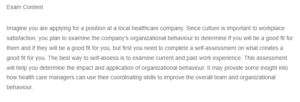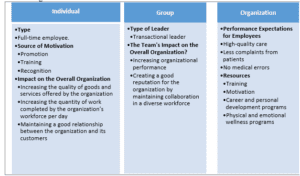Organizational Behavior Levels
Part 1: Organizational Behavior Levels
Part 2: Reflection
Key Learnings about Effective Organizational Behavior
One of the things that I have learned about effective organizational behaviour is that it is linked to the organization’s leadership and the interaction between employees. Retno (2017) states that leaders influence an organization’s values, tolerance to change, culture, and employee motivation. Leaders can support an organization’s values by helping employees develop and grow different values through recognition, goal setting, and creating growth opportunities. Leaders can increase tolerance for change by supporting employees throughout the change process, leading by example, and addressing employee grievances throughout the change implementation process. Leaders influence an organization’s culture by promoting specific employee traits and behaviours, such as innovation. Leaders also influence employee motivation by selecting appropriate motivation techniques and performance evaluation processes. The interaction between employees may contribute to effective organizational behaviour by creating a work environment that encourages specific conduct, such as diversity and inclusion, employee involvement in decision-making, and outlining the chain of command. The second thing I have learned about effective organizational behaviour is that it can increase an organization’s performance and productivity through employee motivation, boosting employee satisfaction, fostering better leadership, and encouraging collaboration among employees and leaders.
How I Can Impact Organizational Behavior at My Workplace
I can impact organizational behaviour at my workplace in different ways. For example, I can contribute to the organization’s organizational behaviour by meeting its expectations. Some of the expectations I can meet include maintaining a high quality of care, being cautious when caring for patients to avoid medical errors, and meeting patients’ needs to prevent complaints. I can also contribute to the organization’s organizational behaviour by being aggressive to promote healthy competition with my colleagues, leading to increased organizational performance. The third thing I can do to support my organization’s behaviour is to follow the policies and procedures that all employees must follow. I can also align my goals with the organization’s goals to ensure that my actions do not conflict with the organization’s objectives. I can also suggest changes that can be made to support my workplace’s organizational behaviour. I can also offer feedback on the effectiveness of my workplace’s organizational behaviour.
Organizational Behavior in the Success or Failure of an Organization
Hammond (2016) states good organizational behaviour can increase employee performance, satisfaction, and engagement. Therefore, organizational behaviour can lead to the success of an organization by increasing employee motivation through increased job satisfaction and engagement in decision-making. Organizational behaviour can also lead to the success of an organization by encouraging healthy competition among employees, thus increasing employee productivity, which enhances organizational performance and success. Organizational behavior can also improve collaboration among employees, thus facilitating the exchange of ideas that can be used to boost the organization’s performance.
However, organizational behavior should be monitored to prevent bad behavior that could lead to an organization’s failure. For example, negative organizational behavior, such as discrimination against some employees, can lead to the failure of an organization. For example, discrimination can create an organization’s bad reputation, leading to massive losses. An organization can also be sued for discriminating against employees, leading to losses from legal fees. Organizational behavior can also lead to the failure of an organization by sending the wrong message to employees, leading to reduced productivity. For instance, suppose an organization does not care about its employee’s welfare through fair compensation and offering a safe workplace. In that case, employees may get the impression that it is only concerned about maximizing profit, which will lead to reduced morale and productivity.
References
Hammond, M. (2016). Introducing organizational behaviour. Organizational Behaviour, 1-22. https://doi.org/10.1057/978-1-137-42945-2_1.
Retno. (2017). Relationship between servant leadership in organizational culture, organizational commitment, organizational citizenship behaviour and customer satisfaction. EUROPEAN RESEARCH STUDIES JOURNAL, XX (Issue 3A), 554-569. https://doi.org/10.35808/ersj/728.
ORDER A PLAGIARISM-FREE PAPER HERE
We’ll write everything from scratch
Question
Exam Content
Imagine you are applying for a position at a local healthcare company. Since culture is important to workplace satisfaction, you plan to examine the company’s organizational behaviour to determine if you will be a good fit for them and if they will be a good fit for you, but first you need to complete a self-assessment on what creates a good fit for you. The best way to self-assess is to examine current and past work experience. This assessment will help you determine the impact and application of organizational behaviour. It may provide some insight into how health care managers can use their coordinating skills to improve the overall team and organizational behaviour.

Organizational Behavior Levels
Preparing for the Assessment
Consider the infographic below. Organizational behaviour starts and ends with people, particularly how individuals, groups, and the organization communicate and interact with each other – positively or negatively. Research aspects of culture and organizational behaviour as you complete the grid for this assessment.
Individual circle within a group circle within an organization circle. For individuals: What type of employee are you? What motivates you in a work setting (e.g., training, empowerment, etc.)? How do you, as an employee, impact the overall organization? For group: What type of leader do you have? How does your team impact the overall organization? For organization: What are the performance expectations for employees (i.e., high sales, quality of care, etc.)? What resources does the company put into their employees (i.e., empowerment, training, etc.)?
Assessment Deliverable
Part 1
Use the circle grid as inspiration as you create an outline of the following prompts for an organization you currently work for or one you worked for in the past. Note: The organization you choose doesn’t have to be health care specific.
This is a self-assessment activity and needs to be understandable to the reader but does not need to be in paragraph or paper format. Consider phrase or sentence-length answers for the prompts. Note: You are welcome to recreate the circle grid above (or another visual) to share the following answers if you prefer.
Individual
What type of employee are you?
What motivates you in a work setting (e.g., training, empowerment, etc.)?
What impact do you, as an employee, have on the overall organization?
Group
What type of leader do you have?
What impact does your team have on the overall organization?
Organization
What are the performance expectations for employees (i.e., high sales, quality of care, etc.)?
What resources does the company put into its employees (i.e., empowerment, training, etc.)?
Part 2
Write a 350- to 525-word reflection addressing the following questions:
What did you learn about effective organizational behaviour?
How can you impact organizational behaviour at your workplace?
How can organizational behaviour lead to the success or failure of an organization?
Cite at least one source with an associated reference.


